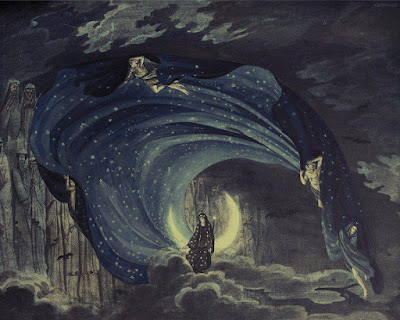A
tomte today is a mythological creature from Nordic folklore that is typically associated with the winter solstice and the Christmas season. It is called a
nisse in Denmark and Norway, and either a
tomtenisse or
tonttu in Finland. It is generally described as being no taller than 35 inches, having a long white beard, and they wear a conical or knit cap in red or another bright color. They are close in appearance to a garden gnome. It is one of the most familiar creatures of Scandinavian folklore, and has appeared in many works of Nordic literature. In English editions of the fairy tales of Hans Christian Andersen, the word
nisse has been wrongly translated as "goblin" - it is more like an English brownie or hob.
The
tomte is an echo of an ancient ancestral cult, according to folklorists. He was sometimes seen as the farmer who cleared the forest to build the farm, and who, in pre-Christian days, would have been buried on the farm within a mound. The words
tomte and
tonttu are derived from the term for a place of residence and area of influence: the house lot is
tomt in Swedish and
tontti in Finnish. According to tradition, the
tomte lives in the houses and barns of the farmstead, and secretly act as their guardian. If treated well, they protect the family and farm animals from evil and misfortune, and they may also aid in farm chores and work. However, they are known to be short tempered, especially when offended. Once insulted, they usually play tricks, steal items, and will even maim or kill livestock.
Originally, the
tomte was described as a small elderly man (the size of a
tomte varies from a few inches to about 35 inches), and he often has a full beard. He is dressed in the traditional garb of a farmer, consisting of a pull-over woolen tunic belted at the waist, and knee breeches with stockings and clogs, boots, or shoes. There are also folktales saying that he is skilled in illusions, and can be invisible or become the size of a giant. People only get glimpses of him, so he is hard to describe. Norwegian folklore states that he has four fingers, pointed ears, and has reflective eyes, like a cat.
Despite his small size the
tomte possesses immense strength. In some tales, in return for some kindness, he performs the work of ten men and brings good fortune to the farm owner and his family. But he is easily offended by lazy farmers and a lack of respect, and by rudeness. He performs retributions for bad farm management and practices, ranging from a smack on the ear to ruining the farm's fortune. For him, observance of traditions is important, and changes in work habits or care of things upset him. Rude farm workers could expect a beating.
One is also expected to please and appease the
tomte with gifts; a special gift is a bowl of porridge on Christmas night, with a large pat of butter on the top. If the
tomte is not given his gift, he might leave the house, barn, or steading; he might turn objects upside down, or break things; or he might tie the cows' tails together in a knot.
The
tomte is connected to farm animals in general, but his most treasured animal is the horse or pony. Belief had it that one could see which equine was the
tomte's favorite, as it would be especially healthy and well taken care of. Occasionally the
tomte would braid the horse's mane and tail; undoing the braids could anger the spirit, and bad fortune might follow.
During and after the Christianization of Scandinavia, the
tomte was not a popular figure. As a creature of folklore, he was seen as heathen, and connected to the Devil. Farmers believing in the house or farm
tomte could be viewed as worshiping false gods and/or demons. Saint Birgitta warns against the worship of
tompta gudhi (tomte gods) in a famous 14th century decree. At that time, having a
tomte on the farm meant that you had put your soul at risk, and it was believed that you had to perform various nefarious non-Christian rites to lure the spirit to your farm. The belief in a
tomte's tendency to bring riches to the farm by his unseen work could also be dragged into conflicts between neighbors. If one farmer was doing better for himself than the others, someone might accuse him of having a
tomte, who was doing "ungodly" work and probably stealing from the neighbors. A farmer accused of such a thing could be damaged by word and shunning, as it was like accusations of witchcraft during the Inquisitions.
The
tomte was originally a solitary creature, but today he is frequently pictured with other
tomtar as a social creature. He shares many aspects with other Scandinavian wights that are social creatures. Names for different types of Scandinavian home spirits, in English, include yard dweller, yard warden, good farmer, yard spirit, and barn gnome. In Finland, there is a sauna gnome. In Sweden a
tomte may become a ship gnome.
In other European countries, folklore has many similar beings, such as the Scots and English brownie, the Northumbrian English hob, the English West Country pixie, the Dutch
kabouter, the Slavic
domovoi, or the German
Heinzelmannchen.
** I keep a small statue of a tomte eating a candy cane on my mantel. **






















































